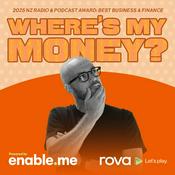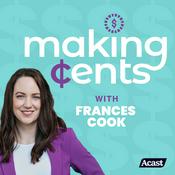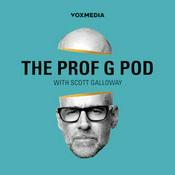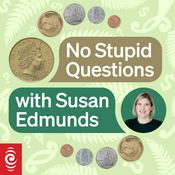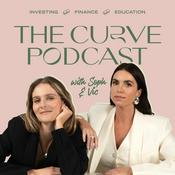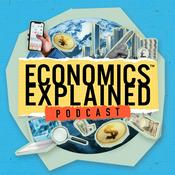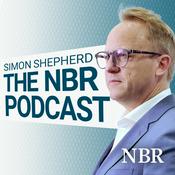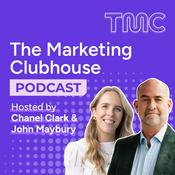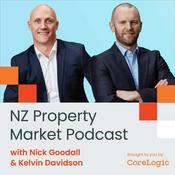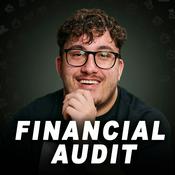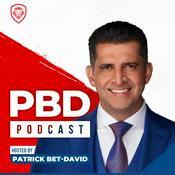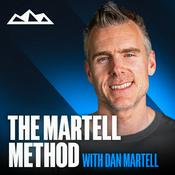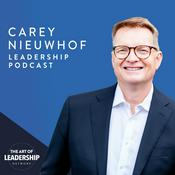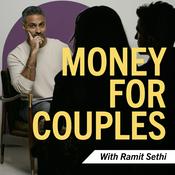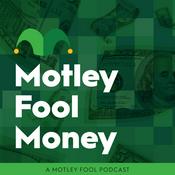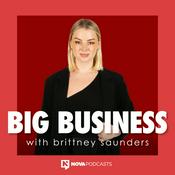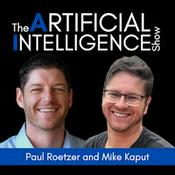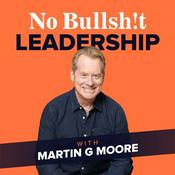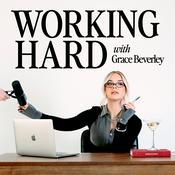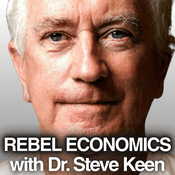Available Episodes
5 of 94
- “Banks are HIDING something from us” Top Economist Warnshttps://cyber.stevekeen.comGet exclusive Cyber Monday bonuses including Unlimited Ravel use (my proprietary software I use in this video), Q&A calls with me, 100-Day Guarantee and other exclusives at https://cyber.stevekeen.com⌛️ Ends on Monday Dec 1st 11:59PM EST.Banks don’t “lend out” your deposits, they create money when they lend.In this video, Steve Keen dissects the classcial economist's fractional-reserve story, responds to critics, and uses Ravel to show why the classic money-multiplier only “works” if loans are made in cash. Once you enforce real double-entry bookkeeping, the narrative collapses — and the real mechanics of bank-originated money and debt come into focus.What you’ll learn• Why the textbook money-multiplier breaks under proper accounting• How bank lending creates deposits (new money) on both sides of the ledger• Why reserves ≠ “loanable funds” and why deposits aren’t lent out• Where popular explanations violate assets = liabilities + equity• Why getting money creation right matters for debates on deficits, QE/QT, and “can we afford it?”• How Ravel exposes hidden assumptions in neat verbal stories — step by stepKey takeaways• If a model can’t balance the T-accounts, it’s wrong, regardless of how often it’s taught.• Loans create deposits; deposits aren’t a stockpile that gets parcelled out.• Cash is the only way to make the textbook multiplier arithmetic “work”, which tells you the model is not how modern banking operates.• Misunderstanding bank money leads to bad policy: deficit panic, confused takes on QE/QT, and misguided bank rules.About Steve KeenSteve Keen is an economist known for accounting-consistent, data-driven models of money, debt, and instability. Creator of the Minsky and Ravel tools, he replaces classroom myths with operational mechanics you can simulate and test.• Weekly live access & Q&A• Cohort of rigorous, curious learners• Ravel included for accepted students who joinSupport reality-based economics• Subscribe for more Ravel walk-throughs and myth-busting• Like if this clarified how banks actually create money• Share with someone still quoting the money-multiplierGet exclusive Cyber Monday bonuses including Unlimited Ravel use, Q&A calls with me, 100-Day Guarantee and other exclusives at 👉 https://cyber.stevekeen.com#economicseducation #moneycreation #banks #doubleentrysystem #ravel #macroeconomics #fiscalpolicy #monetarypolicy #banking101 #stevekeen--------10:27
- "Housing market is in its worst condition ever" Top Economist warnshttps://cyber.stevekeen.comGet exclusive Cyber Monday bonuses including Unlimited Ravel use (my proprietary software I use in this video), Q&A calls with me, 100-Day Guarantee and other exclusives at https://cyber.stevekeen.com⌛️ Ends on Monday Dec 1st 11:59PM EST.Why are homes unaffordable from London to Sydney?Steve Keen shows why the standard “supply & demand” story misses the engine underneath modern housing bubbles: bank-originated mortgage credit. Using long-run BIS datasets, Steve tracks how real house prices decoupled from consumer prices after the 1980s as banks ramped mortgage lending. The kicker: it’s not just the level of mortgage debt that drives prices — it’s the change in the change of mortgage debt. That credit pulse explains booms, busts, and today’s squeeze.What you’ll learn• Why real house prices were flat for a century… then went vertical after the 1980s• How bank lending (not “savers’ deposits”) creates new purchasing power for housing• The critical driver: ΔΔ Mortgage Debt → Δ Real House Prices (UK, US, Australia, more)• Why simple correlations mislead — and why differencing reveals the true causal link• How rising inequality and speculative demand amplify bank-fueled price cycles• Policy levers that actually bite: credit guidance, LTV/DTI caps, and curbing mortgage speculationKey takeaways• Housing became a credit-fueled asset: prices outran CPI and wages because banks created the demand.• The credit impulse (change in the change of household debt) best explains house-price swings.• Countries without a visible “crash” can still be in an oversized, fragile credit cycle.• Taming bubbles means steering bank credit toward productive uses — not bidding wars for existing homes.Policy ideas discussedCredit guidance for banks: prioritize business working capital & durable goods; restrict mortgage speculation.Macroprudential limits: tighten LTV/DTI during upswings; countercyclical buffers that lean against credit booms.Re-align incentives: discourage flipping/empty-home speculation; reward new supply without turbo-charging land prices.Measure what matters: track private-debt ratios and the credit impulse alongside CPI/unemployment.------About Steve KeenSteve Keen builds accounting-consistent, data-driven models of money, debt, and instability. Creator of Minsky and Ravel, he replaces classroom myths with the operational mechanics you can simulate and test.Get exclusive Cyber Monday bonuses including Unlimited Ravel use (the software I use in this video), Q&A calls with me, 100-Day Guarantee and other exclusives at 👉 https://cyber.stevekeen.com⌛️ Ends on Monday Dec 1st 11:59PM EST.• Weekly live Q&A access• Cohort of rigorous learners• Ravel included for accepted students who joinSupport reality-based economics• Subscribe for more Ravel walk-throughs and housing myth-busting• Like if this reframed housing beyond “just build more” takes• Share with anyone who thinks deposits fund mortgages#housingcrisis #houseprices #mortgagedebt #CreditImpulse #PrivateDebt #BIS #Ravel #Macroeconomics #FinancialStability #Inequality #UKHousing #australiahousing #ushousingmarket #SteveKeen--------10:58
- “Britain’s financial crisis no one is admitting” Top Economist WarnsLearn 50+ Years of Economics in Only 7 Weeks: apply at https://www.stevekeen.com(Bonus: accepted students who join get Ravel — the double-entry, macro visualization tool used in this video.)Steve Keen sits down with Sky’s Ed Conway to stress-test the OBR’s terrifying long-run debt charts (274%… 600%+ of GDP) and shows why they rest on a false banking model. Using Ravel, Steve compares the textbook “loanable funds” view with the Bank of England’s 2014 statement on how money is actually created (banks create deposits when they lend). The result: debt-panic projections collapse, and a saner policy mix comes into view.What you’ll learn• Why “banks as mere intermediaries” breaks macro logic — and the forecasts built on it• The BoE’s money creation mechanism vs. the textbook story — and why it matters for deficits• How government deficits create fiat money, and why that’s a feature, not a bug• Why secondary bond sales by banks to non-banks destroy deposits (and how to rein that in)• How QE/QT and rate hikes ripple through bond prices, bank balance sheets, and yields• Why private debt and credit growth are the true cyclical drivers — and why policymakers ignore them• Practical fixes: deficit-fund essential services, cap secondary bond offloads, guide credit away from asset bubblesKey takeaways• OBR-style “debt to the sky” charts depend on a loanable-funds world that doesn’t exist.• In the real world, bank lending creates deposits; credit affects demand and GDP.• Deficits add fiat money to private balances and need not imply a debt doom loop.• Private debt and credit swings drive unemployment and crises; government debt usually reacts after the fact.• QT plus rapid rate hikes compress bond prices and can destabilize banks; policy must account for this transmission.Policy prescriptions discussedRun deficits to fund real needs (healthcare, winter heating, critical services).Limit banks’ secondary bond sales to non-banks (or sell new gilts directly to the central bank and pay interest on reserves).Use credit guidance: allow lending for productive business working capital and major consumer durables; restrict mortgage/asset-price speculation.Target private-debt/credit metrics in macro policy (e.g., keep private debt ≤ ~100% of GDP).About Steve KeenSteve Keen is an economist known for accounting-consistent, data-driven models of money, debt, and instability. Creator of the Minsky and Ravel tools, he replaces classroom myths with operational mechanics you can simulate and test.Try the Seven-Week Rebel Economist ChallengeApply here: https://www.stevekeen.com• Weekly live access for Q&A• Cohort of like-minded learners• Ravel software included for accepted students who joinSupport reality-based economics• Subscribe for more Ravel walk-throughs and myth-busting• Like if this clarified why “debt doom” charts go off the rails• Share with someone who follows fiscal headlines#Economics #SteveKeen #EdConway #UKDebt #OBR #BankOfEngland #Ravel #PrivateDebt #CreditCycles #QE #QT #BondYields #FiscalPolicy #Macro--------21:52
- “Brutal Truth: UK Housing Market 2025" Top Economist warnsLearn 50+ Years of Economics in Only 7 Weeks, by applying here: https://www.stevekeen.com(Plus get Ravel — the economic visualization software used in this video — as a bonus if you’re accepted and join.)📢 This is a reupload of the original video with improved visuals and audio for a better viewing experience.Top Economist Steve Keen breaks down why the UK’s housing market has gone from “crisis” to “ticking time bomb.” With long-run data and Ravel demos, Steve shows how deregulated mortgage lending not mere shortage pushed the price-to-income ratio from ~4.5× in the post-war era to ~9× today, and lays out two concrete, workable policies to restore affordability: PILL (Property Income Limited Leverage) and an Affordable Housing Authority offering zero-interest mortgages for median and below-median earners.In this video, you’ll discover:✅ Why today’s 9× price-to-income rivals 1876 — and what changed after the 1980s✅ Building societies vs banks: why one didn’t create money and the other does✅ How bank-created mortgage credit inflates prices far faster than wages✅ The post-Thatcher break: household debt explodes, real house prices double faster✅ PILL: cap mortgages to a multiple of rental income and phase it down toward ~10×✅ AHA: zero-interest public lending that turns “housing stress” into manageable payments✅ Why both must run together (one cools leverage, the other preserves access)✅ Bonus history: Ford and Edison’s case for interest-free public finance — and why it matters nowKey insights:• Price without leverage is fiction: new mortgage credit is the main source of housing demand.• Deregulation shifted lending from building societies to banks — expanding money and bidding up existing homes.• At 7% interest, over half of lifetime payments are interest; at 0%, typical payments drop near the 30% “stress” threshold.• Pairing PILL with AHA bends prices down while keeping doors open for average earners.• Private debt — not public debt — is the core macro risk behind UK housing volatility.Subscribe for reality-based economicsLike if this clarified why UK homes keep outrunning wagesShare to help others see what actually drives prices---Who is Dr. Steve Keen?Dr. Steve Keen is an economist known for accounting-consistent, data-driven models showing how bank money and private debt drive booms, busts, and asset bubbles. Creator of the Minsky and Ravel tools, he replaces classroom myths with operational mechanics — essential for engineers, finance professionals, and anyone who wants clarity over ideology.Learn 50+ Years of Economics in Only 7 Weeks, by applying here: [https://www.stevekeen.com](https://www.stevekeen.com)(Plus get Ravel — the software used in this video — as a bonus if you’re accepted and join.)#UKDebt #MoneyCreation #ukeconomy #BOMD #SteveKeen #Ravel #Macroeconomics #FiscalPolicy #BankingSystem--------12:14
- “The real problem isn't deficits, It's Neoliberalism“ Top Economist warnsLearn 50+ Years of Economics in Only 7 Weeks, by applying here: https://www.stevekeen.comThis video is an extended version of previous video - "Deficits aren't the danger to the US, THIS is..." Top Economist warns(Plus get Ravel — the economic visualization software used in this video — as a bonus if you’re accepted and join.)Economist Steve Keen explains how decades of neoliberal U.S. policies have turned government deficits into a dangerous economic cycle. Using clear double-entry accounting and Ravel visualizations, Steve reveals how the obsession with balanced budgets and market deregulation has weakened the real economy, inflated private debt, and set the stage for financial collapse.He breaks down how bank lending still creates most of the money in circulation, why government deficits actually build deposits and reserves, and how open-market operations merely reshuffle assets instead of generating real wealth. Finally, Steve proposes a Modern Debt Jubilee — a practical path to reset the system, reduce unpayable private debts, and restore long-term financial stability without falling into the illusion of “printing money.”In this breakdown, you’ll discover:✅ Cash vs digital money: why the press in DC is a sideshow✅ Government spending and taxes in the ledger: deposits up, taxes down — what really changes✅ Reserves 101: what banks can and can’t do with them (and why they aren’t “spendable” money)✅ Deficit mechanics: why deficits create both money and reserves, surpluses destroy them✅ The eight entries you need to model government money creation (beyond simple double entry)✅ Why “borrowed from the private sector” is an accounting myth in loanable-funds models✅ How OMOs and QE actually work: when they create money, when they don’t✅ The data picture: since 2000, most new money has been credit-backed (private), not fiscal✅ Why government negative financial equity is normal — and necessary for private net financial assetsKey insights:• Deficit is not a bug — it’s the feature that creates net financial assets for the private sector.• Reserves are bank-to-central-bank balances; they support payments and bond settlement, not your latte.• Open-market operations with non-banks can create money; purchases from banks swap assets inside the banking system.• Loanable-funds thinking explodes government debt in theory because it excludes money creation in the first place.• Accounting done properly shows government negative financial equity mirrors private positive equity.-----What did you think of the eight-entry walkthrough and the OMO/QE distinctions? Share your thoughts below.Subscribe for reality-based economicsLike if this clarified how deficits, reserves, and QE actually workShare to help others move beyond textbook myths-----Who is Dr. Steve Keen?Dr. Steve Keen is an economist known for accounting-consistent, data-driven models that explain how bank money, private debt, and policy operations shape the real economy. Creator of the Minsky and Ravel tools, he replaces classroom analogies with operational mechanics — essential for engineers, finance professionals, and anyone who wants clarity over ideology.Learn 50+ Years of Economics in Only 7 Weeks, by applying here: https://www.stevekeen.com(Plus get Ravel — the software used in this video — as a bonus if you’re accepted and join.)#usshutdown #usdebtcrisis #useconomy #usdebt #BankingSystem #QE #economics #money #Macroeconomics #usgovernment--------34:57
More Business podcasts
Trending Business podcasts
About Rebel Economics with Dr. Steve Keen
Learn 50+ Years of Economics in 10 mins a day. Go watch my most popular economic lesson here: 👉 go.stevekeen.com 👈
---
Join Dr. Steve Keen as he shows you how he predicted the 2008 Financial Crisis YEARS before it happened.
Welcome to Rebel Economics with Dr. Steve Keen, hosted by the distinguished economist, author, and professor known for his critical perspectives on mainstream economics. In this podcast, Dr. Keen dives deep into the world of economics, debunking traditional theories and offering insights into how economies actually work. You'll explore topics ranging from debt dynamics to environmental sustainability and the pitfalls of economic orthodoxy. Join Dr. Keen as he navigates the complex terrain from theoretical economics to practical solutions, armed with his decades of research and a relentless pursuit of economic justice. Whether you're an economics student, a professional in the field, or simply curious about the economic forces that shape our world, Rebel Economics with Dr. Steve Keen is your gateway to understanding economics beyond the mainstream.
Podcast websiteListen to Rebel Economics with Dr. Steve Keen, The Diary Of A CEO with Steven Bartlett and many other podcasts from around the world with the radio.net app
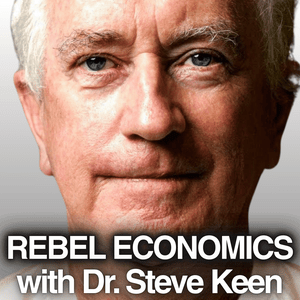
Get the free radio.net app
- Stations and podcasts to bookmark
- Stream via Wi-Fi or Bluetooth
- Supports Carplay & Android Auto
- Many other app features
Get the free radio.net app
- Stations and podcasts to bookmark
- Stream via Wi-Fi or Bluetooth
- Supports Carplay & Android Auto
- Many other app features


Rebel Economics with Dr. Steve Keen
Scan code,
download the app,
start listening.
download the app,
start listening.



